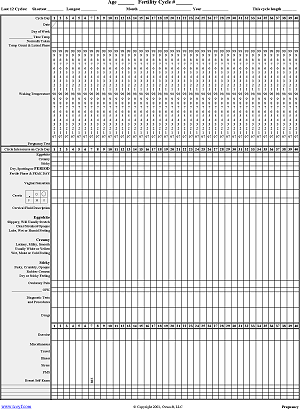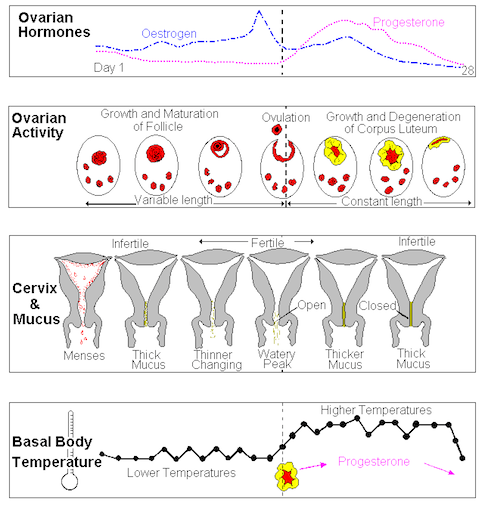Ladies, you may have noticed that you’re special. Your body does incredible things! And, it has its own unique way to promote your individual female health, sexuality, and reproduction. Experiencing changes throughout your lifetime, your body goes through puberty to fertility, pregnancy to menopause, and every month the cycle of menstruation (the build up and release of the lining of your uterus). This indicates another cycle of fertility that has come and gone, but it can also tell us about our bodies.
First, it provides us with the knowledge to prevent pregnancy without using hormonal birth control. And conversely, it can be used to promote pregnancy during the most fertile days. Our cycle can even speak to us about our overall health.
So, let’s dive into a quick explanation of charting your female cycle utilizing the best resources out there.
Day 1
The first day of your period is considered Day 1 of your cycle. It’s important to know for fertility tracking apps

as well as the more traditional analog paper charting method.

As you chart your cycle, it’s important to not be on any hormonal birth control, as this will change the signs your body gives about your fertility.
If you’re trying to avoid pregnancy, you may want to consider using a non-hormonal form of birth control such as condoms.
What’s happening in your cycle?
The days after your period, your hormones will begin to switch gears and start building the lining of your uterus again. Simply put, this is the “fertile phase” before ovulation, when estrogen is dominating your hormones, keeping your body cool while it chooses an egg to send into your fallopian tubes during ovulation. First thing every morning, take the temperature of your body at rest, and record this number to chart the switch to progesterone, when ovulation is taking place.
If you have sex during this fertile phase, semen can live inside of your body for up to five days, due to the production of cervical mucus—another sign of your fertility! You may have noticed white discharge in your underwear, but have you noticed that it changes at different parts of your cycle too?
It’s usually absent the first few days after your period but then starts to build up and thicken as you approach ovulation. After ovulation, it begins to dry up again. When charting, note that this cervical mucus changes everyday.
Your body is encouraging semen to enter the uterus and fallopian tubes where the egg is released. Thus, it brings the cervix up higher inside your body, softening and opening slightly. Again, you can notice daily changes by exploring your body until you reach the cervix.

Once the body switches to a warmer progesterone state, the cervical mucus begins to decrease, and the cervix hardens and descends. This is your body communicating that ovulation has occurred.
An egg lives 12-24 hours in order to be fertilized by sperm. If not, the egg dies, and you’re now “infertile” for the rest of your cycle.
If 17 days after ovulation, you’ve not received your period and your temperature remains high, congratulations: you’re pregnant!
What Can Charting Do?
Charting can get you in touch with the rhythms and cycles of your incredible body. It can dispel myths about when you can or cannot get pregnant. And it can help you make fertility plans with your partner. Not to mention that it can also help you switch from hormonal birth control to a birth control more in sync with your body. Or it can pinpoint ovulation, and help you get pregnant if you’re trying!
This process can also show us when we’re ovulating later in the month, due to stress or travel, and it can highlight the impact that it has on our health and bodies. In some cases, it helped women discover their own hypothryrodism by noting consistently low body temperatures. Contact your doctor if you have any questions.
Helpful Books
- Nofziger, Margaret. A Cooperative Method of Natural Birth Control. Summertown, TN: Book Pub., 1992. Print.
- Singer, Katie. The Garden of Fertility: A Guide to Charting Your Fertility Signals to Prevent or Achieve Pregnancy–naturally–and to Gauge Your Reproductive Health. New York: Avery, 2003. Print.
- Singer, Katie. Honoring Our Cycles: A Natural Family Planning Workbook. Winona Lake, IN: New Trends, 2006. Print.
- The Boston Women’s Health Collective. Our Bodies, Ourselves. New York: Simon & Schuster, 2011. Print.
- Weschler, Toni. Taking Charge of Your Fertility: The Definitive Guide to Natural Birth Control, Pregnancy Achievement, and Reproductive Health. New York, NY: Collins, 2006. Print.
Many blessings on your journey to body awareness!
Hannah






